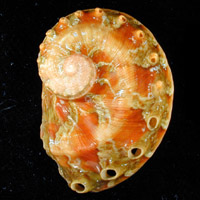|
< Previous family introduction |
|
 |
Family
Haliotidae
Abalones
|
|
Abalones have a flattened shell with mother-of-pearl interior, and a row of siphonal holes a short distance in from the edge of the shell. Water is drawn into the mantle cavity, passed over the gills and expelled through the siphonal holes. They have a large, flat foot (the edible part of the animal) with which they adhere to rocky surfaces. They are grazers on marine algae, living on exposed rocky shores at low tide level and down to about 50 metres. At low tide level they conceal themselves under rocks and in crevices, but subtidally large individuals graze in more open situations. Fertilisation is external, with eggs and sperm being discharged into the water. Only three species occur in NSW. There is only one large species, Haliotis rubra, which reaches a shell width of about 200 mm. It occurs throughout southern Australia, and is commercially fished in NSW, Victoria and SA. The other two species are smaller, both being less than 75 mm in width, and are restricted to eastern Australia. Family references:
Coverage: All NSW species are figured.
|
|